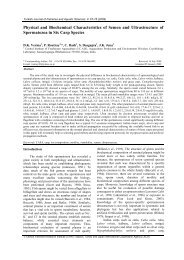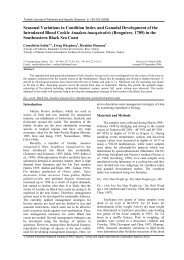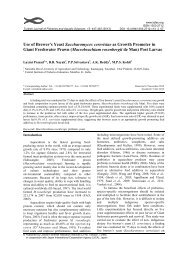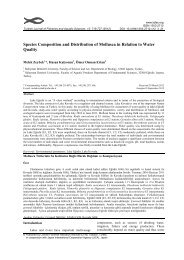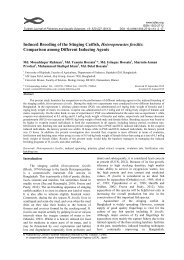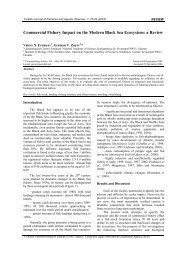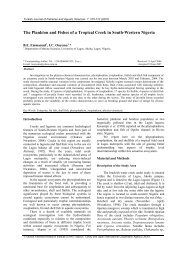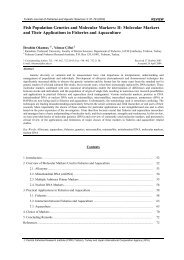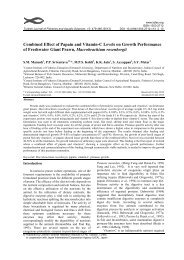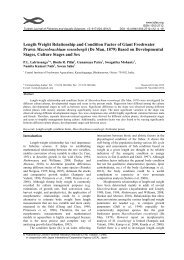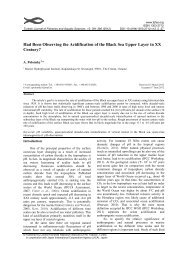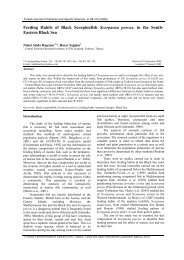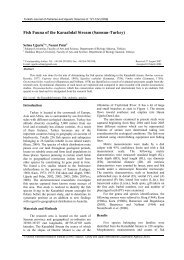Effects of Sodium Bicarbonate on Anaesthesia of Common Carp ...
Effects of Sodium Bicarbonate on Anaesthesia of Common Carp ...
Effects of Sodium Bicarbonate on Anaesthesia of Common Carp ...
You also want an ePaper? Increase the reach of your titles
YUMPU automatically turns print PDFs into web optimized ePapers that Google loves.
Turkish Journal <str<strong>on</strong>g>of</str<strong>on</strong>g> Fisheries and Aquatic Sciences 9: 29-31 (2009)<br />
<str<strong>on</strong>g>Effects</str<strong>on</strong>g> <str<strong>on</strong>g>of</str<strong>on</strong>g> <str<strong>on</strong>g>Sodium</str<strong>on</strong>g> <str<strong>on</strong>g>Bicarb<strong>on</strong>ate</str<strong>on</strong>g> <strong>on</strong> <strong>Anaesthesia</strong> <str<strong>on</strong>g>of</str<strong>on</strong>g> Comm<strong>on</strong> <strong>Carp</strong> (Cyprinus<br />
carpio L., 1758) Juveniles<br />
Tülay Altun 1 , Ramazan Bilgin 2 , Durali Danabaş 1, *<br />
1 Çukurova University, Fisheries Faculty, Aquaculture Department, 01330 Adana, Turkey.<br />
2<br />
Çukurova University, Faculty <str<strong>on</strong>g>of</str<strong>on</strong>g> Science and Letters, Chemical Department, 01330 Adana, Turkey.<br />
* Corresp<strong>on</strong>ding Author: Tel.: +90.322 3386084-2961-160; Fax: +90.322 3386439;<br />
E-mail: dalid07@gmail.com<br />
Abstract<br />
Received 21 March 2008<br />
Accepted 03 December 2008<br />
In current study, anaesthetic effects <str<strong>on</strong>g>of</str<strong>on</strong>g> sodium bicarb<strong>on</strong>ate (NaHCO 3 ) in 6 c<strong>on</strong>centrati<strong>on</strong>s were determined in comm<strong>on</strong><br />
carp (Cyprinus carpio) juveniles (7.70±0.4 g and 8.38±0.8 cm) kept in two different pH levels and at 23°C water<br />
temperature. Its effective c<strong>on</strong>centrati<strong>on</strong>s were 1000 and 600 mg L -1 in pH 6.5 and 7.7, respectively. While stage <str<strong>on</strong>g>of</str<strong>on</strong>g><br />
anaesthesia and recovery time increased, inducti<strong>on</strong> time decreased; opercular rate firstly increased but than slowly decreased<br />
with increasing the c<strong>on</strong>centrati<strong>on</strong> <str<strong>on</strong>g>of</str<strong>on</strong>g> anaesthetic in both pH. No mortality was observed in the study. Applicati<strong>on</strong>s <str<strong>on</strong>g>of</str<strong>on</strong>g><br />
NaHCO 3 in high pH levels, seems to be suitable <strong>on</strong> anaesthesia <str<strong>on</strong>g>of</str<strong>on</strong>g> comm<strong>on</strong> carp.<br />
Keywords: Cyprinus carpio, sodium bicarb<strong>on</strong>ate, inducti<strong>on</strong> time, recovery time, opercular rate, pH, water temperature<br />
Introducti<strong>on</strong><br />
<str<strong>on</strong>g>Sodium</str<strong>on</strong>g> bicarb<strong>on</strong>ate (NaHCO 3 ) known as baking<br />
soda, is white in color, dissolved in water easily and<br />
gives carb<strong>on</strong> dioxide when dissolved in water. Carb<strong>on</strong><br />
dioxide gas is listed for anaesthetic purposes in cold,<br />
cool and warm water fishes and has been used<br />
primarily to sedate fish during transport or to allow<br />
handling <str<strong>on</strong>g>of</str<strong>on</strong>g> large numbers <str<strong>on</strong>g>of</str<strong>on</strong>g> fish (Bowser, 2001). It<br />
was firstly described as a fish anaesthetic by Fish<br />
(1942). It is safe for human and there is no banning or<br />
restricti<strong>on</strong>s in its using (Summerfeld and Smith, 1990;<br />
Çetinkaya and Şahin, 2005). It might also be <strong>on</strong>ly<br />
partly effective at immobilizing fish, slow acting, and<br />
lethal after repeated exposures (Marking and Meyer,<br />
1985). Carb<strong>on</strong> dioxide gas is soluble in water. The gas<br />
is bubbled in the water. It is introduced into the water<br />
either directly through an air st<strong>on</strong>e or indirectly by<br />
additi<strong>on</strong> <str<strong>on</strong>g>of</str<strong>on</strong>g> sodium bicarb<strong>on</strong>ate as a source <str<strong>on</strong>g>of</str<strong>on</strong>g> carb<strong>on</strong><br />
dioxide. When NaHCO 3 is dissolved in water, it<br />
slowly releases carb<strong>on</strong> dioxide gas (Prince et al.,<br />
1995; Bowser, 2001).<br />
While this is somewhat effective in<br />
immobilizing fish, deep anesthesia is difficult to<br />
achieve (Prince et al., 1995). The authors reported<br />
that anesthesia stage 4 <str<strong>on</strong>g>of</str<strong>on</strong>g> 5 informed by Keene et al.<br />
(1998) could be achieved in adult sockeye salm<strong>on</strong><br />
Oncorhynchus nerka within about 6 minutes;<br />
however, it was noted that the procedure should be<br />
tested to determine appropriate c<strong>on</strong>centrati<strong>on</strong>s <strong>on</strong><br />
n<strong>on</strong>salm<strong>on</strong>ids.<br />
Booke et al. (1978) studied the effects <str<strong>on</strong>g>of</str<strong>on</strong>g><br />
NaHCO 3 <strong>on</strong> comm<strong>on</strong> carp juveniles at <strong>on</strong>ly low<br />
temperature (10ºC). They are acclimated the fish to<br />
low water temperature in the laboratory during 10<br />
days before treatment for this applicati<strong>on</strong>.<br />
In fisheries researches and aquaculture, some<br />
applicati<strong>on</strong>s such as weighing or transporting the<br />
fishes from p<strong>on</strong>d to p<strong>on</strong>d should be carried out in a<br />
short time. Optimum water temperature for growth <str<strong>on</strong>g>of</str<strong>on</strong>g><br />
Cyprinus carpio is around 25°C (Juriaan et al., 2003).<br />
The decreasing <str<strong>on</strong>g>of</str<strong>on</strong>g> water temperature may cause stress<br />
<strong>on</strong> fishes. So the determining the effects <str<strong>on</strong>g>of</str<strong>on</strong>g><br />
anaesthetics appearing <strong>on</strong> the fishes at their natural<br />
ambient water temperature is important.<br />
Main aim <str<strong>on</strong>g>of</str<strong>on</strong>g> the current study was to determine<br />
the effective anaesthetic c<strong>on</strong>centrati<strong>on</strong>s <str<strong>on</strong>g>of</str<strong>on</strong>g> sodium<br />
bicarb<strong>on</strong>ate as an anaesthetic in different water pH<br />
c<strong>on</strong>diti<strong>on</strong>s and at an its optimal water temperature <strong>on</strong><br />
a n<strong>on</strong>salm<strong>on</strong>id fresh water fish, comm<strong>on</strong> carp<br />
(Cyprinus carpio L, 1758) juveniles.<br />
Materials and Methods<br />
Comm<strong>on</strong> carp (7.70±0.4 g and 8.38±0.8 cm) was<br />
obtained from Fisheries Department, Regi<strong>on</strong>al<br />
Directorate <str<strong>on</strong>g>of</str<strong>on</strong>g> State Hydraulic Works (Adana). The<br />
experiment was carried out in glass aquaria (5 L) in<br />
laboratory <str<strong>on</strong>g>of</str<strong>on</strong>g> Fisheries Faculty <str<strong>on</strong>g>of</str<strong>on</strong>g> University <str<strong>on</strong>g>of</str<strong>on</strong>g><br />
Cukurova. All <str<strong>on</strong>g>of</str<strong>on</strong>g> the fish were starved for 24 h prior<br />
to experiment (Weyl et al., 1996).<br />
Experiment was performed out at 23ºC water<br />
temperature and in triplicate. Comm<strong>on</strong> carp generally<br />
prefers slightly acidic or alkali ambience and its<br />
optimal pH range is 6.5-9.0 (Tekelioğlu, 2000; FAO,<br />
2008). For this reas<strong>on</strong>, two water resources having<br />
different pH level were used in this experiment; <strong>on</strong>e<br />
<str<strong>on</strong>g>of</str<strong>on</strong>g> them was tap water (natural pH level 7.7) used in<br />
the laboratory and the other was adjusted (to 6.5 pH)<br />
by adding hydrochloric acid (HCl) (37%), 12<br />
normality (Merck) to this water. <str<strong>on</strong>g>Sodium</str<strong>on</strong>g> bicarb<strong>on</strong>ate<br />
(NaHCO 3 ) (extra pure, Merck) in 6 c<strong>on</strong>centrati<strong>on</strong>s (0<br />
(c<strong>on</strong>trol), 200, 400, 600, 800, 1000 mg L -1 for 6.5 pH,<br />
© Central Fisheries Research Institute (CFRI) Trabz<strong>on</strong>, Turkey and Japan Internati<strong>on</strong>al Cooperati<strong>on</strong> Agency (JICA)
30 T. Altun et al. / Turk. J. Fish. Aquat. Sci. 9: 29-31 (2009)<br />
and 0 (c<strong>on</strong>trol), 400, 600, 1000, 1400, 2000 mg L -1 for<br />
7.7 pH) was added into each aquarium and water was<br />
mixed. The c<strong>on</strong>centrati<strong>on</strong>s were established by taking<br />
into c<strong>on</strong>siderati<strong>on</strong> <str<strong>on</strong>g>of</str<strong>on</strong>g> the results obtained from<br />
previous studies (Booke et al., 1978; Prince et al.,<br />
1995). Because NaHCO 3 alters pH, pH level <str<strong>on</strong>g>of</str<strong>on</strong>g> the<br />
water in each aquarium was measured, when fish was<br />
stocked. Measurements <str<strong>on</strong>g>of</str<strong>on</strong>g> pH and temperature <str<strong>on</strong>g>of</str<strong>on</strong>g> the<br />
water was carried out by pH meter (Toledo mark).<br />
After adding the anaesthetic agent, five fish was<br />
stocked into the each aquarium. When fish reached<br />
anaesthesia, inducti<strong>on</strong> time, anaesthesia stage,<br />
opercular rate and mortality <str<strong>on</strong>g>of</str<strong>on</strong>g> the fish were noted. It<br />
is generally accepted that there are five stages <str<strong>on</strong>g>of</str<strong>on</strong>g><br />
anaesthesia in fish (Coyle et al., 2004): however, in<br />
aquaculture applicati<strong>on</strong>s, stages were informed in<br />
different number and feature in previous studies. In<br />
this study, fish was observed for four different<br />
anaesthesia stages shown below and modified from<br />
anaesthesia stages identified by Abbas et al. (2006):<br />
1. Tranquility period (slow swimming and slight<br />
increase in opercular rate),<br />
2. Excitati<strong>on</strong> period (unrest voluntary swimming,<br />
still possible increase in opercular rate high<br />
reacti<strong>on</strong> to external stimuli),<br />
3. Light anaesthesia level (turning to <strong>on</strong>e side, still<br />
reacti<strong>on</strong> to external stimuli, high opercular rate<br />
loss <str<strong>on</strong>g>of</str<strong>on</strong>g> co-ordinati<strong>on</strong> excrement discharge)<br />
4. Deep anaesthesia (lying <strong>on</strong> <strong>on</strong>e side without<br />
movement, opercular movement very high (up to<br />
200 min -1 ) in some <str<strong>on</strong>g>of</str<strong>on</strong>g> the fish and very low (9-<br />
17 min L -1 ) in others increase in excrement<br />
discharge high reacti<strong>on</strong> to external stimuli in fish<br />
with a high opercular rate, and no reacti<strong>on</strong>s to<br />
external stimuli in those with a slow opercular<br />
rate).<br />
After the anaesthesia, fish was removed from<br />
anaesthetic added water and transferred to clean water<br />
aquarium. Recovery time was recorded and fish was<br />
maintained there for 48h in order to observe possible<br />
mortality.<br />
Results<br />
Anaesthetic effects <str<strong>on</strong>g>of</str<strong>on</strong>g> NaHCO 3 in different<br />
c<strong>on</strong>centrati<strong>on</strong>s and pH values at 23°C <strong>on</strong> comm<strong>on</strong><br />
carp were shown in Table 1.<br />
After stocking into the treatment aquaria, fish<br />
began to swim towards to aquarium walls and became<br />
hyperactive in first <strong>on</strong>e or two minutes in each group.<br />
Then, fish gathered in together and began to enter the<br />
anaesthesia. An increase in the c<strong>on</strong>centrati<strong>on</strong> <str<strong>on</strong>g>of</str<strong>on</strong>g><br />
NaHCO 3 increased pH level <str<strong>on</strong>g>of</str<strong>on</strong>g> the water, slightly<br />
(Table 1).<br />
In pH 6.5, fish reached from 1 to 3 <str<strong>on</strong>g>of</str<strong>on</strong>g> the<br />
anaesthesia stage; however, <strong>on</strong>ly half <str<strong>on</strong>g>of</str<strong>on</strong>g> the fish<br />
entered the 3 rd stage <str<strong>on</strong>g>of</str<strong>on</strong>g> anaesthesia in the highest<br />
c<strong>on</strong>centrati<strong>on</strong>. Only the 3 rd stage <str<strong>on</strong>g>of</str<strong>on</strong>g> anaesthesia could<br />
be seen in all c<strong>on</strong>centrati<strong>on</strong>s except first c<strong>on</strong>centrati<strong>on</strong><br />
<str<strong>on</strong>g>of</str<strong>on</strong>g> pH 7.7.<br />
Inducti<strong>on</strong> time decreased with increasing <str<strong>on</strong>g>of</str<strong>on</strong>g> the<br />
c<strong>on</strong>centrati<strong>on</strong> <str<strong>on</strong>g>of</str<strong>on</strong>g> NaHCO 3 in both pH treatments; to<br />
average 7 in pH 6.5 but to average 4 in pH 7.7.<br />
Recovery time increased with an increase in the<br />
c<strong>on</strong>centrati<strong>on</strong> in both water resources. Opercular rate<br />
firstly increased and then slowly decreased with<br />
increasing the c<strong>on</strong>centrati<strong>on</strong> <str<strong>on</strong>g>of</str<strong>on</strong>g> anaesthetic in both pH<br />
levels (Table 1).<br />
No mortality was recorded in any c<strong>on</strong>centrati<strong>on</strong><br />
<str<strong>on</strong>g>of</str<strong>on</strong>g> NaHCO 3 during the applicati<strong>on</strong> and post recovery<br />
period.<br />
Discussi<strong>on</strong><br />
It is suggested that pH-c<strong>on</strong>trolled carb<strong>on</strong> dioxide<br />
release from the sodium bicarb<strong>on</strong>ate caused the<br />
anesthetic resp<strong>on</strong>se (Booke et al., 1978). Thus, pH<br />
level <str<strong>on</strong>g>of</str<strong>on</strong>g> the water after additi<strong>on</strong> <str<strong>on</strong>g>of</str<strong>on</strong>g> NaHCO 3 generally<br />
was adjusted with HCl (Booke et al., 1978) and<br />
sulphuric acid (H 2 SO 4 ) (Hseu et al., 1995) and glacial<br />
acetic acid (CH 3 COOH) (Quinlan, 1997). In this<br />
study, HCl was used.<br />
The result that the fish become hyperactive in<br />
<strong>on</strong>e or two minutes is similar with the result informed<br />
for brook trout (Salvelinus f<strong>on</strong>tinalis) by Quinlan<br />
(1997).<br />
Booke et al. (1978) implied that NaHCO 3 at<br />
combinati<strong>on</strong> 642 mg L -1 , pH 6.5 (10ºC) <strong>on</strong> comm<strong>on</strong><br />
carp was the most effective for causing the fish to<br />
cease locomoti<strong>on</strong> and slow opercular rate, but to<br />
retain reflex resp<strong>on</strong>se to pressure <strong>on</strong> the caudal fin.<br />
In the present study (23ºC), the best results were<br />
seen in the c<strong>on</strong>centrati<strong>on</strong>s <str<strong>on</strong>g>of</str<strong>on</strong>g> 1,000 mg L -1 and 600 mg<br />
L -1 for the water resources which pH levels were 6.5<br />
and 7.7, respectively before adding NaHCO 3 .<br />
C<strong>on</strong>centrati<strong>on</strong> <str<strong>on</strong>g>of</str<strong>on</strong>g> NaHCO 3 to reach the stage <str<strong>on</strong>g>of</str<strong>on</strong>g><br />
anaesthesia 3 in pH 6.5 was higher (1000 mg L -1 ) than<br />
results <str<strong>on</strong>g>of</str<strong>on</strong>g> species (rainbow trout (Oncorhynchus<br />
mykiss), brook trout (Salvelinus f<strong>on</strong>tinalis) and<br />
comm<strong>on</strong> carp (Cyprinus carpio)) in study <str<strong>on</strong>g>of</str<strong>on</strong>g> Booke et<br />
al. (1978).<br />
With increasing <str<strong>on</strong>g>of</str<strong>on</strong>g> the water temperature,<br />
solubility <str<strong>on</strong>g>of</str<strong>on</strong>g> NaHCO 3 increases (An<strong>on</strong>ymous, 2006a).<br />
However, any increment in temperature slightly<br />
decreases solubility and CO 2 level <str<strong>on</strong>g>of</str<strong>on</strong>g> water (Cirik and<br />
Cirik, 1991; Wedemeyer, 1996; Göksu, 2003). So,<br />
more NaHCO 3 (1000 mg L -1 ) was used to anaesthetize<br />
comm<strong>on</strong> carp in this study than that <str<strong>on</strong>g>of</str<strong>on</strong>g> Booke et al.<br />
(1978).<br />
In c<strong>on</strong>trast to Booke et al. (1978), stages <str<strong>on</strong>g>of</str<strong>on</strong>g><br />
anaesthesia were higher in the same c<strong>on</strong>centrati<strong>on</strong>s <str<strong>on</strong>g>of</str<strong>on</strong>g><br />
pH 7.7 than those in pH 6.5 in this study. This can<br />
indicate that high pH level <str<strong>on</strong>g>of</str<strong>on</strong>g> the water is more<br />
suitable to anaesthetize the fish with NaHCO 3 in this<br />
temperature. Already, NaHCO 3 dissolved more in<br />
high pH level; additi<strong>on</strong>ally NaHCO 3 increases the<br />
water pH level (An<strong>on</strong>ymous, 2006b) as seen in Table<br />
1 <str<strong>on</strong>g>of</str<strong>on</strong>g> this study.
T. Altun et al. / Turk. J. Fish. Aquat. Sci. 9: 29-31 (2009) 31<br />
Table 1. Anaesthetic effects <str<strong>on</strong>g>of</str<strong>on</strong>g> NaHCO 3 (mg L -1 ) at 23°C in different pH levels <strong>on</strong> comm<strong>on</strong> carp<br />
pH Level <str<strong>on</strong>g>of</str<strong>on</strong>g> the<br />
Water Before<br />
Adding NaHCO 3<br />
6.5<br />
7.7<br />
C<strong>on</strong>centrati<strong>on</strong>s <str<strong>on</strong>g>of</str<strong>on</strong>g><br />
Anaesthetic (mg/L)<br />
pH Level <str<strong>on</strong>g>of</str<strong>on</strong>g> the<br />
Water After Adding<br />
NaHCO 3<br />
Stage <str<strong>on</strong>g>of</str<strong>on</strong>g><br />
anaesthesia<br />
Inducti<strong>on</strong><br />
time (min)<br />
Recovery<br />
time (min)<br />
Opercular rate<br />
(per/min)<br />
0 (C<strong>on</strong>trol) - - - 78±3.6<br />
200 7.00 1 9 1-2 125±6.5<br />
400 7.11 1 8 1-2 130±3.8<br />
600 7.25 2 7.5 3-4 111±4.2<br />
800 7.38 2 7 9 102±6.0<br />
1000 7.47 2-3 7 10 105±4.3<br />
0 (C<strong>on</strong>trol) - - - 2 78±3.1<br />
400 8.19 2 7 5-6 85±2.0<br />
600 8.27 3 7 5-6-7 113±4.3<br />
1000 8.40 3 5 10 100±4.7<br />
1400 8.47 3 5 11 85±3.2<br />
2000 8.53 3 4 14 72±1.7<br />
Inducti<strong>on</strong> time, recovery times and opercular<br />
rate <str<strong>on</strong>g>of</str<strong>on</strong>g> the fish can vary depending <strong>on</strong> c<strong>on</strong>centrati<strong>on</strong><br />
<str<strong>on</strong>g>of</str<strong>on</strong>g> anaesthetic (Booke et al., 1978; Hseu, 1995; Yanar<br />
and Kumlu, 2001). In NaHCO 3 applicati<strong>on</strong>, inducti<strong>on</strong><br />
time for comm<strong>on</strong> carp changed between 4-12 min;<br />
recovery time was 15 min for 3 rd stage <str<strong>on</strong>g>of</str<strong>on</strong>g> anaesthesia<br />
(Booke et al., 1978). Inducti<strong>on</strong> times for this stage in<br />
all c<strong>on</strong>centrati<strong>on</strong>s <str<strong>on</strong>g>of</str<strong>on</strong>g> present study were in<br />
harm<strong>on</strong>ious with the result <str<strong>on</strong>g>of</str<strong>on</strong>g> the authors but recovery<br />
times were shorter.<br />
C<strong>on</strong>sequently, this study highlighted that high<br />
c<strong>on</strong>centrati<strong>on</strong> <str<strong>on</strong>g>of</str<strong>on</strong>g> NaHCO 3 is needed in order to<br />
anaesthetize comm<strong>on</strong> carp juveniles at higher<br />
temperatures including optimal water temperature for<br />
growth. Additi<strong>on</strong>ally, NaHCO 3 applicati<strong>on</strong>s at high<br />
pH level can be a good alternative to other<br />
anaesthetics.<br />
References<br />
Abbas, H.H.H., Abdel-Gawad, A.S. and Akkr, A.A. 2006.<br />
Toxicity and Efficacy <str<strong>on</strong>g>of</str<strong>on</strong>g> Lidocaine as an Anesthetic<br />
for Nile Tilapia; Oreochromis niloticus. Online<br />
Journal <str<strong>on</strong>g>of</str<strong>on</strong>g> Veterinary Research, 10(1): 31-41.<br />
An<strong>on</strong>ymous. 2006a. Online introductory chemistry<br />
solubility: How solubility is measured.<br />
http://www.800mainstreet.com/9/0009-004-olub.html.<br />
An<strong>on</strong>ymous. 2006b. CO 2 and KH. http://fins.actwin.com<br />
/aquatic-lants/m<strong>on</strong>th.9505/ msg00183.html.<br />
Booke, H.E., Hollender, B. and Lutterbie, G. 1978. <str<strong>on</strong>g>Sodium</str<strong>on</strong>g><br />
bicarb<strong>on</strong>ate, an inexpensive fish anesthetic for field<br />
use. Progressive Fish Culturist., 40(1): 11-13.<br />
Bowser, P.R. 2001. Anesthetic opti<strong>on</strong>s for fish. In: R.D.<br />
Gleed and J.W. Ludders (Eds.), Recent advances in<br />
veterinary anaesthesia and analgesia: Compani<strong>on</strong><br />
animals, internati<strong>on</strong>al veterinary informati<strong>on</strong> service<br />
(www.ivis.org), Ithaca, New York, USA.<br />
Cirik, S. and Cirik, Ş. 1991. Limnoloji. Ege University<br />
Press, Su Ürünleri Fakültesi Yayın No: 21 Bornova,<br />
İzmir, 166 pp. (in Turkish).<br />
Çetinkaya, O. and Şahin, A. 2005. <strong>Anaesthesia</strong> applicati<strong>on</strong>s<br />
<strong>on</strong> fish and main anaesthetics. In: M. Karataş (Ed.),<br />
Research techniques in fish biology Part 9, Nobel<br />
publishing, Ankara: 237-275 (in Turkish).<br />
Coyle, S.D., Durborow, R.M. and Tidwell, J.H. 2004.<br />
Anesthetics in Aquaculture. SRAC Publicati<strong>on</strong> No.<br />
3900, Texas, 6 pp.<br />
FAO, 2008. Cultured aquatic species informati<strong>on</strong><br />
programme Cyprinus carpio (Linnaeus, 1758).<br />
http://www.fao.org/fishery/culturedspecies/Cyprinus_<br />
carpio<br />
Göksu Lugal, M.Z. 2003. Water Polluti<strong>on</strong>. Text Book.<br />
Publicait<strong>on</strong> <str<strong>on</strong>g>of</str<strong>on</strong>g> Fisheries Fac., Universty <str<strong>on</strong>g>of</str<strong>on</strong>g> Cukurova,<br />
No:7, Adana, 232 pp (in Turkish).<br />
Fish, F.F. 1942. The anaesthesia <str<strong>on</strong>g>of</str<strong>on</strong>g> fish by high carb<strong>on</strong><br />
dioxide c<strong>on</strong>centrati<strong>on</strong>s. Trans. Am. Fish. Soc., 72: 25–<br />
29.<br />
Hseu J.R, Yeh, S.L., Chu, Y.T. and Ting, Y.Y. 1995.<br />
Applicati<strong>on</strong> <str<strong>on</strong>g>of</str<strong>on</strong>g> sodium bicarb<strong>on</strong>ate and sulfuric acid<br />
for anesthetizati<strong>on</strong> <str<strong>on</strong>g>of</str<strong>on</strong>g> black porgy Acanthopagrus<br />
schlegeli. Journal <str<strong>on</strong>g>of</str<strong>on</strong>g> Taiwan Fisheries Research., 3(2):<br />
151-159.<br />
Juriaan, R. M., Erwin, H., Van den Burg Sjoerd, E.W.B.<br />
and Gert, F. 2003. Regulati<strong>on</strong> <str<strong>on</strong>g>of</str<strong>on</strong>g> branchial Na/K-<br />
ATPase in comm<strong>on</strong> carp Cyprinus carpio L.<br />
acclimated to different temperatures. The Journal <str<strong>on</strong>g>of</str<strong>on</strong>g><br />
Experimental Bioloy, 206: 2273-2280.<br />
Keene, J.K., Noakes, D.L.G., Moccia, R.D. and Soto, C.D.<br />
1998. The efficacy clove oil as an anaesthetic for<br />
rainbow trout, Oncorhynchus mykiss (Walbaum).<br />
Aquaculture Research, 29: 89-101.<br />
Marking, L.L. and Meyer, F.P. 1985. Are better anesthetics<br />
needed in fisheries Fisheries, 10(6): 2-5.<br />
Prince, A.M.J., Low, S.E., Lissimore, T.J., Diewert, R.E.<br />
and Hinch, S.G. 1995. <str<strong>on</strong>g>Sodium</str<strong>on</strong>g> bicarb<strong>on</strong>ate and acetic<br />
acid: an effective anesthetic for field use. North<br />
American J. <str<strong>on</strong>g>of</str<strong>on</strong>g> Fisheries Management, 15:170–172.<br />
Quinlan, H. 1997. A test for anesthetizing hatchery brook<br />
trout with sodium bicarb<strong>on</strong>ate and glacial acetic acid.<br />
Midwest tribal aquaculture network, Dedicated to the<br />
tribal aquaculture program. www.fws.gov/r3pao/<br />
ashland/mtan/mtanhome.html.<br />
Summerfelt, R.C. and Smith, L.S. 1990. <strong>Anaesthesia</strong>,<br />
surgery and related techniques. In: C.B. Schreck and<br />
P.B. Moyle (Eds.), Methods for Fish Biology.<br />
American Fisheries Society, Bedhesda MD: 213-272.<br />
Tekelioğlu, N. 2000. Inland fish culture (in Turkish).<br />
Çukurova University Fisheries Faculty, No: 2, Adana.<br />
Wedemeyer, G.A. 1996. Physiology <str<strong>on</strong>g>of</str<strong>on</strong>g> Fish in Intensive<br />
Culture Systems. Chapman and Hall. USA. 232p.<br />
Weyl O., Kaiser, H. and Hecht, T. 1996. On the efficacy<br />
and mode <str<strong>on</strong>g>of</str<strong>on</strong>g> acti<strong>on</strong> <str<strong>on</strong>g>of</str<strong>on</strong>g> 2-phenoxyethanol as an<br />
anaesthetic for goldfish, Carassius auratus (L.), at<br />
different temperatures and c<strong>on</strong>centrati<strong>on</strong>s.<br />
Aquaculture Research, 27: 757-764.



